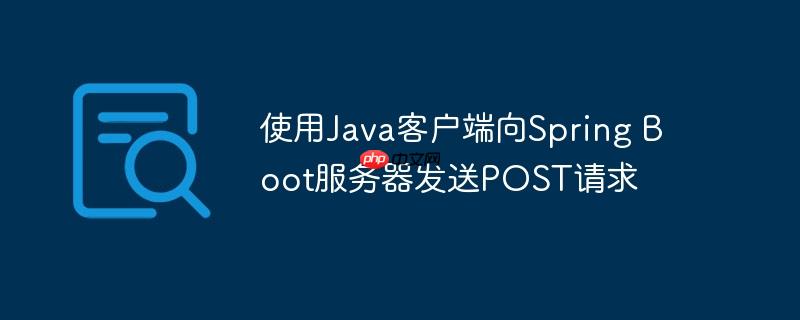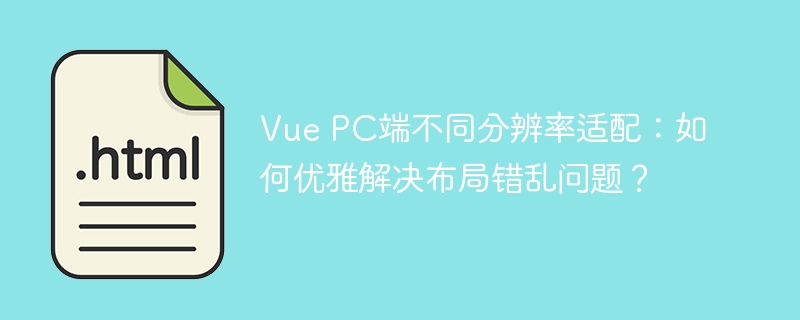
本文档旨在指导开发者如何使用Java客户端向spring Boot服务器发送POST请求。文章将首先介绍问题背景,然后提供两种解决方案:一种是使用httpURLConnection,另一种是使用Java 11引入的HttpClient。我们将详细讲解每种方法的实现步骤,并提供完整的代码示例,帮助开发者快速掌握POST请求的发送方法,并解决spring boot服务端无法接收POST请求的问题。
使用 HttpURLConnection 发送 POST 请求
HttpURLConnection 是 Java 标准库中提供的用于进行 HTTP 通信的类。虽然它功能强大,但使用起来相对繁琐。以下是使用 HttpURLConnection 发送 POST 请求的步骤和代码示例:
-
创建 URL 对象: 使用 Spring Boot 服务器的 URL 创建 URL 对象。
String url = "http://127.0.0.1:8090/online"; URL mUrl = new URL(url);
-
打开连接: 使用 URL 对象的 openConnection() 方法打开一个 HttpURLConnection 连接。
立即学习“Java免费学习笔记(深入)”;
HttpURLConnection urlConn = (HttpURLConnection) mUrl.openConnection();
-
设置请求方法: 设置请求方法为 POST。
urlConn.setRequestMethod("POST"); -
设置请求头: 设置 Content-Type 请求头,指定请求体的媒体类型。
urlConn.setRequestProperty("Content-Type", "text/plain; charset=UTF-8");注意: Content-Type 非常重要,Spring Boot 才能正确解析请求体。常用的类型包括 application/json (JSON 数据), application/x-www-form-urlencoded (表单数据), 和 text/plain (纯文本数据)。 根据你的 Spring Boot 服务端期望接收的类型来设置。
-
允许输出: 设置 DoOutput 为 true,允许向服务器发送数据。
urlConn.setDoOutput(true);
-
写入请求体: 获取输出流,并将请求体数据写入。
String query = "Body"; try (OutputStream os = urlConn.getOutputStream()) { byte[] input = query.getBytes(StandardCharsets.UTF_8); os.write(input, 0, input.length); } -
获取响应: 获取响应码,并读取响应内容。
int responseCode = urlConn.getResponseCode(); System.out.println("Response Code : " + responseCode); try (BufferedReader br = new BufferedReader(new InputStreamReader(urlConn.getInputStream(), StandardCharsets.UTF_8))) { StringBuilder response = new StringBuilder(); String responseLine = null; while ((responseLine = br.readLine()) != null) { response.append(responseLine.trim()); } System.out.println(response.toString()); } -
断开连接: 关闭连接。
urlConn.disconnect();
完整示例代码:
import java.io.BufferedReader; import java.io.IOException; import java.io.InputStreamReader; import java.io.OutputStream; import java.net.HttpURLConnection; import java.net.URL; import java.nio.charset.StandardCharsets; public class HttpURLConnectionExample { public static void main(String[] args) throws IOException { String url = "http://127.0.0.1:8090/online"; URL mUrl = new URL(url); HttpURLConnection urlConn = (HttpURLConnection) mUrl.openConnection(); urlConn.setRequestMethod("POST"); urlConn.setRequestProperty("Content-Type", "text/plain; charset=UTF-8"); urlConn.setDoOutput(true); String query = "Body"; try (OutputStream os = urlConn.getOutputStream()) { byte[] input = query.getBytes(StandardCharsets.UTF_8); os.write(input, 0, input.length); } int responseCode = urlConn.getResponseCode(); System.out.println("Response Code : " + responseCode); try (BufferedReader br = new BufferedReader(new InputStreamReader(urlConn.getInputStream(), StandardCharsets.UTF_8))) { StringBuilder response = new StringBuilder(); String responseLine = null; while ((responseLine = br.readLine()) != null) { response.append(responseLine.trim()); } System.out.println(response.toString()); } urlConn.disconnect(); } }
使用 HttpClient (Java 11+) 发送 POST 请求
Java 11 引入了新的 HttpClient API,它提供了更简洁、更现代化的方式来发送 HTTP 请求。以下是使用 HttpClient 发送 POST 请求的步骤和代码示例:
-
创建 HttpClient 对象: 使用 HttpClient.newHttpClient() 创建一个 HttpClient 实例。
HttpClient client = HttpClient.newHttpClient();
-
创建 HttpRequest 对象: 使用 HttpRequest.newBuilder() 构建一个 HttpRequest 对象。你需要指定 URL, 请求方法 (POST), 和请求体。
String url = "http://127.0.0.1:8090/online"; String query = "Body"; HttpRequest request = HttpRequest.newBuilder() .uri(URI.create(url)) .header("Content-Type", "text/plain; charset=UTF-8") // 设置 Content-Type .POST(HttpRequest.BodyPublishers.ofString(query, StandardCharsets.UTF_8)) .build();注意: 同样,Content-Type 的设置非常重要,需要与 Spring Boot 服务端期望的类型一致。 HttpRequest.BodyPublishers.ofString() 方法用于创建请求体。
-
发送请求: 使用 HttpClient 的 send() 方法发送请求,并获取响应。
HttpResponse<String> response = client.send(request, HttpResponse.BodyHandlers.ofString());
HttpResponse.BodyHandlers.ofString() 指定响应体的内容类型为 String。
-
处理响应: 获取响应状态码和响应体。
System.out.println("Response Status Code: " + response.statusCode()); System.out.println("Response Body: " + response.body());
完整示例代码:
import java.io.IOException; import java.net.URI; import java.net.http.HttpClient; import java.net.http.HttpRequest; import java.net.http.HttpResponse; import java.nio.charset.StandardCharsets; public class HttpClientExample { public static void main(String[] args) throws IOException, InterruptedException { HttpClient client = HttpClient.newHttpClient(); String url = "http://127.0.0.1:8090/online"; String query = "Body"; HttpRequest request = HttpRequest.newBuilder() .uri(URI.create(url)) .header("Content-Type", "text/plain; charset=UTF-8") .POST(HttpRequest.BodyPublishers.ofString(query, StandardCharsets.UTF_8)) .build(); HttpResponse<String> response = client.send(request, HttpResponse.BodyHandlers.ofString()); System.out.println("Response Status Code: " + response.statusCode()); System.out.println("Response Body: " + response.body()); } }
Spring Boot 服务端代码示例
确保你的 Spring Boot 服务端能够正确接收 POST 请求。以下是一个简单的示例:
import org.springframework.http.HttpStatus; import org.springframework.http.ResponseEntity; import org.springframework.web.bind.annotation.PostMapping; import org.springframework.web.bind.annotation.RequestBody; import org.springframework.web.bind.annotation.RestController; @RestController public class MessageService { @PostMapping(path = "/online", consumes = "text/plain") // 指定 consumes public ResponseEntity<?> getResponse(@RequestBody String requestBody){ System.out.println("Post Recieved: " + requestBody); return new ResponseEntity<>("Received: " + requestBody, HttpStatus.OK); } }
关键点:
- @PostMapping 注解: 使用 @PostMapping 注解来处理 POST 请求。
- path 属性: 设置 path 属性来指定请求路径。
- consumes 属性: 设置 consumes 属性来指定服务端能够处理的 Content-Type。 确保它与客户端发送的 Content-Type 一致。 在这个例子中,我们指定 consumes = “text/plain”,表示服务端期望接收纯文本数据。
- @RequestBody 注解: 使用 @RequestBody 注解来接收请求体数据。
总结与注意事项
- Content-Type 匹配: 确保客户端发送的 Content-Type 与 Spring Boot 服务端 consumes 属性指定的类型匹配。这是最常见的问题原因。
- 字符编码: 在发送和接收数据时,始终指定字符编码 (例如 UTF-8),以避免乱码问题。
- 依赖: 如果使用 HttpClient,请确保你的项目使用了 Java 11 或更高版本。
- 异常处理: 在实际应用中,需要添加适当的异常处理代码,以处理网络连接、IO 错误等问题。
- 调试: 使用网络抓包工具 (例如 wireshark) 可以帮助你分析 HTTP 请求和响应,从而更好地调试问题。
通过本文档的学习,你应该能够使用 Java 客户端成功向 Spring Boot 服务器发送 POST 请求。 选择 HttpURLConnection 或 HttpClient 取决于你的项目需求和 Java 版本。 HttpClient 提供了更简洁的 API,推荐在 Java 11+ 环境中使用。 记住,确保 Content-Type 匹配是解决问题的关键。



















